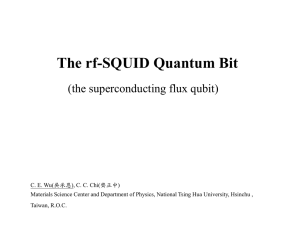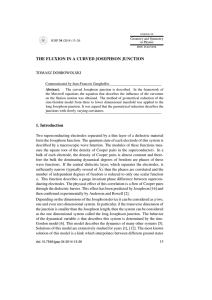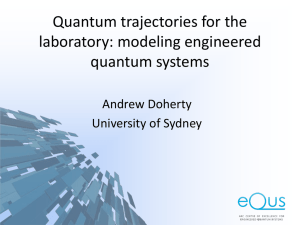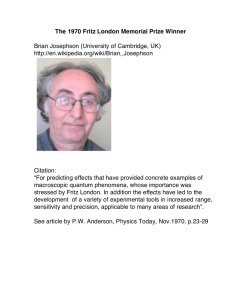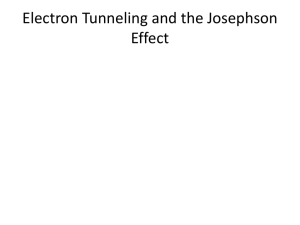Decoherence in Josephson Qubits from Junction Resonances s
advertisement
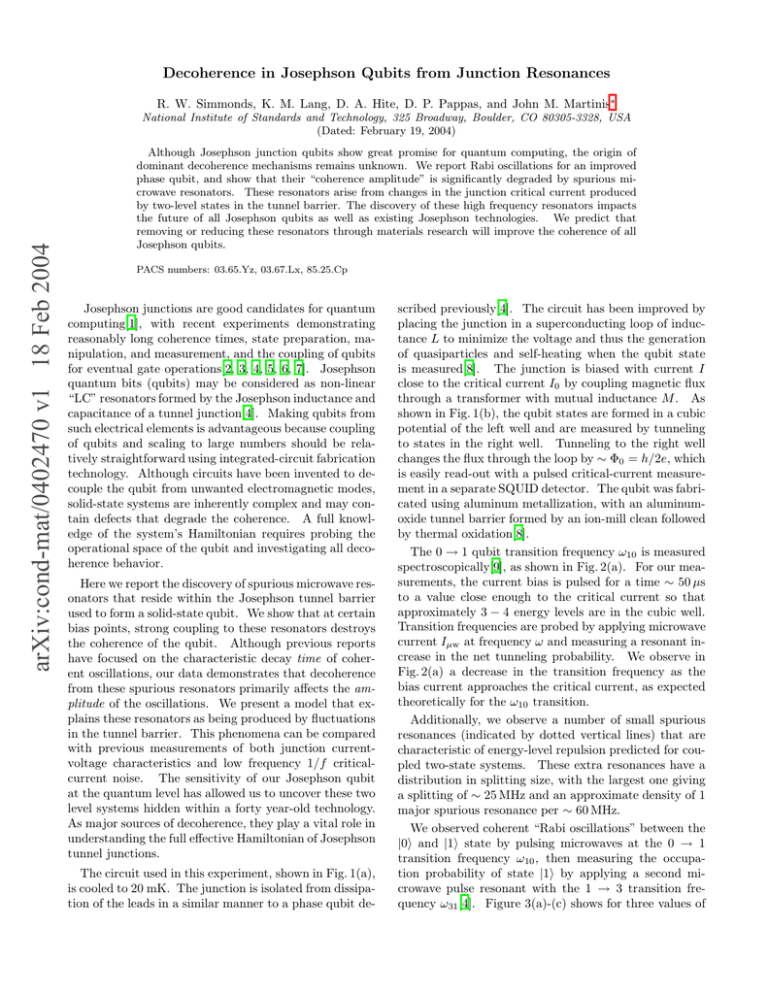
Decoherence in Josephson Qubits from Junction Resonances R. W. Simmonds, K. M. Lang, D. A. Hite, D. P. Pappas, and John M. Martinis∗ arXiv:cond-mat/0402470 v1 18 Feb 2004 National Institute of Standards and Technology, 325 Broadway, Boulder, CO 80305-3328, USA (Dated: February 19, 2004) Although Josephson junction qubits show great promise for quantum computing, the origin of dominant decoherence mechanisms remains unknown. We report Rabi oscillations for an improved phase qubit, and show that their “coherence amplitude” is significantly degraded by spurious microwave resonators. These resonators arise from changes in the junction critical current produced by two-level states in the tunnel barrier. The discovery of these high frequency resonators impacts the future of all Josephson qubits as well as existing Josephson technologies. We predict that removing or reducing these resonators through materials research will improve the coherence of all Josephson qubits. PACS numbers: 03.65.Yz, 03.67.Lx, 85.25.Cp Josephson junctions are good candidates for quantum computing[1], with recent experiments demonstrating reasonably long coherence times, state preparation, manipulation, and measurement, and the coupling of qubits for eventual gate operations[2, 3, 4, 5, 6, 7]. Josephson quantum bits (qubits) may be considered as non-linear “LC” resonators formed by the Josephson inductance and capacitance of a tunnel junction[4]. Making qubits from such electrical elements is advantageous because coupling of qubits and scaling to large numbers should be relatively straightforward using integrated-circuit fabrication technology. Although circuits have been invented to decouple the qubit from unwanted electromagnetic modes, solid-state systems are inherently complex and may contain defects that degrade the coherence. A full knowledge of the system’s Hamiltonian requires probing the operational space of the qubit and investigating all decoherence behavior. Here we report the discovery of spurious microwave resonators that reside within the Josephson tunnel barrier used to form a solid-state qubit. We show that at certain bias points, strong coupling to these resonators destroys the coherence of the qubit. Although previous reports have focused on the characteristic decay time of coherent oscillations, our data demonstrates that decoherence from these spurious resonators primarily affects the amplitude of the oscillations. We present a model that explains these resonators as being produced by fluctuations in the tunnel barrier. This phenomena can be compared with previous measurements of both junction currentvoltage characteristics and low frequency 1/f criticalcurrent noise. The sensitivity of our Josephson qubit at the quantum level has allowed us to uncover these two level systems hidden within a forty year-old technology. As major sources of decoherence, they play a vital role in understanding the full effective Hamiltonian of Josephson tunnel junctions. The circuit used in this experiment, shown in Fig. 1(a), is cooled to 20 mK. The junction is isolated from dissipation of the leads in a similar manner to a phase qubit de- scribed previously[4]. The circuit has been improved by placing the junction in a superconducting loop of inductance L to minimize the voltage and thus the generation of quasiparticles and self-heating when the qubit state is measured[8]. The junction is biased with current I close to the critical current I0 by coupling magnetic flux through a transformer with mutual inductance M . As shown in Fig. 1(b), the qubit states are formed in a cubic potential of the left well and are measured by tunneling to states in the right well. Tunneling to the right well changes the flux through the loop by ∼ Φ0 = h/2e, which is easily read-out with a pulsed critical-current measurement in a separate SQUID detector. The qubit was fabricated using aluminum metallization, with an aluminumoxide tunnel barrier formed by an ion-mill clean followed by thermal oxidation[8]. The 0 → 1 qubit transition frequency ω10 is measured spectroscopically[9], as shown in Fig. 2(a). For our measurements, the current bias is pulsed for a time ∼ 50 µs to a value close enough to the critical current so that approximately 3 − 4 energy levels are in the cubic well. Transition frequencies are probed by applying microwave current Iµw at frequency ω and measuring a resonant increase in the net tunneling probability. We observe in Fig. 2(a) a decrease in the transition frequency as the bias current approaches the critical current, as expected theoretically for the ω10 transition. Additionally, we observe a number of small spurious resonances (indicated by dotted vertical lines) that are characteristic of energy-level repulsion predicted for coupled two-state systems. These extra resonances have a distribution in splitting size, with the largest one giving a splitting of ∼ 25 MHz and an approximate density of 1 major spurious resonance per ∼ 60 MHz. We observed coherent “Rabi oscillations” between the |0i and |1i state by pulsing microwaves at the 0 → 1 transition frequency ω10 , then measuring the occupation probability of state |1i by applying a second microwave pulse resonant with the 1 → 3 transition frequency ω31 [4]. Figure 3(a)-(c) shows for three values of 2 microwave power the occupation probability versus the Rabi pulse time tr at a bias point away from any resonances. The decay of the oscillations is approximately exponential and gives a coherence time of 41 ns. Figure 3(d) shows that the oscillation frequency is proportional to the microwave amplitude, as expected. The correlation between Rabi oscillations and spurious resonances is demonstrated in Fig. 2. For the data in Fig. 2(b), the microwave frequencies of the Rabi and measurement pulses were adjusted with I to center on the transition frequencies obtained from spectroscopy data. We observe that the oscillation amplitude, represented by a variation in color, is suppressed over time (vertical axis) at particular bias currents (horizontal axis). The dashed vertical lines show that this suppression is correlated to those transition frequencies ω10 where there are pronounced resonance structures. It is clear that these spurious resonances strongly disrupt the Rabi oscillations. In Fig. 4 we show the decay of the Rabi oscillations for biases indicated by arrows in Fig. 2(b). Near resonances we find unusual behavior such as beating (b), loss and recovery of the oscillations with time (c), and rapid loss of coherence amplitude (f). The general trend is that spurious resonances cause loss in coherence not by a decrease in the decay time of the oscillations, but by a decrease in the amplitude of the oscillations. Experimental checks were performed to rule out whether these resonances arise from coupling to the readout SQUID or modes in the device mount[10]. Ad- FIG. 1: (a) Circuit diagram for the Josephson junction qubit. Junction current bias I is set by Iφ and microwave source Iµw . Parameters are I0 ≃ 11.659 µA, C ≃ 1.2 pF, L ≃ 168 pH, and L/M ≃ 81. (b) Potential energy diagram of qubit, showing qubit states |0i and |1i in cubic well at left. Measurement of |1i state performed by driving the 1 → 3 transition, tunneling to right well, then relaxation of state to bottom of right well. Post-measurement classical states “0” and “1” differ in flux by Φ0 , which is readily measured by readout SQUID. (c) Schematic description of tunnel-barrier states A and B in a symmetric well. Tunneling between states produces ground |gi and excited |ei states separated in energy by ~ωr . (d) Energy-level diagram for coupled qubit and resonant states for ω10 ≃ ωr . Coupling strength between states |1gi and |0ei e int . is given by H ditionally, simulations show that the beating behavior in Fig. 4 is consistent with the interaction of the qubit with another two level system but not harmonic oscillator modes from the leads of the device. When thermally cycled to room temperature, the magnitude and frequency of the spurious resonances can change considerably, whereas cycling to 4K produces no apparent effect. Furthermore, for the same experimental setup and over 10 qubit devices, we find that each qubit has its own unique “fingerprint” of resonance frequencies and splitting strengths. Finally, over many hours while the device is cold, we observe that resonance frequencies and strengths can change spontaneously. All of these observations indicate that the resonances are microscopic in FIG. 2: (a) Measured probability of state “1” versus microwave excitation frequency ω/2π and bias current I for a fixed microwave power. Data indicate ω10 transition frequency. Dotted vertical lines are centered at spurious resonances. (b) Measured occupation probability of |1i versus Rabi-pulse time tr and bias current I. In panel (b), a color change from dark blue to red corresponds to a probability change of 0.4. Color modulation in time tr (vertical direction) indicates Rabi oscillations. 3 origin. We have constructed a model for the microscopic resonators, where we consider two-level states in the barrier with large tunneling matrix elements corresponding to a microwave frequency[13]. If we consider two states in the tunnel barrier that have configurations A and B producing critical currents I0A and I0B , then the interaction Hamiltonian between the resonance and the critical current is I0A Φ0 cos δb ⊗ |ΨA i hΨA | 2π I0B Φ0 cos δb ⊗ |ΨB i hΨB | , − 2π Hint = − where δb is an operator corresponding to the phase difference across the junction, and ΨA,B describe the two wave functions for the two configuration states within the tunnel barrier. If we assume a symmetric potential with energy eigenstates separated by ~ωr , the ground √ and excited states are given√by |gi ≃ (|ΨA i + |ΨB i)/ 2 and |ei ≃ (|ΨA i − |ΨB i)/ 2. Using matrix elements for cos δb appropriate for the phase qubit[14] and including only the dominant resonant terms arising from this interaction Hamiltonian, we find r ∆I0 ~ e Hint = (|0i h1| ⊗ |ei hg| + |1i h0| ⊗ |gi he|) , 2 2ω10 C where ∆I0 = I0A − I0B . Figure 1(d) shows an energy level diagram for the case where ωr ≈ ω10 . The coue int pling of the two intermediate energy levels through H produces a repulsion in the energy eigenstates that corresponds to the spectroscopic data in Fig. 2(a). From the magnitude of level repulsions at resonance, the largest 1 e int |/h ≃ 25 MHz, we obtain from our value being 2|H model, (∆I0 /I0 )res . 65 · 10−6 . If we assume that the two configurations A and B correspond to turning on and off an individual conduction channel in the tunnel barrier, then (∆I0 /I0 ) can be estimated from the current-voltage characteristics of the junction. For a non-uniform tunnel barrier, mesoscopic theory[15] predicts that the total current flowing through a junction comes from a sum over a number of conduction channels with tunneling transmissions τi . These transmission coefficients can be measured from steps in the subgap current-voltage characteristics[16]. These steps have magnitude 2/τi and arise from nth order multiple Andreev reflections at subharmonic gap voltages 2∆/en. If we assume the current is carried by Nch channels, each with an average transmission τ , then our measured current-voltage characteristics[8] imply τ ≈ 4 · 10−3 for a critical-current density of ∼ 40 A/cm2 . For our qubit junction with a normal-state resistance RN = 29 Ω, we calculate that the average fraction of the critical current carried by each channel is roughly (∆I0 /I0 )I−V = 1/Nch = 2τ RN e2 /h ≃ 8 · 10−6 . This value is in reasonable agreement with those obtained from the magnitudes of the resonance splittings considering that the junction has a distribution of tunneling transmissions τi and our measurements of the level repulsions only identify a small fraction of the largest resonators from their full distribution. We can also compare these results with 1/f critical-current noise measurements at audio frequencies for individual 1/f fluctuators within submicrometer junctions[11, 12, 17]. For an aluminum junction with area 0.08 µm2 , a single fluctuator[12] gave a change in critical current of ∆I0 ≃ 10−4 I0 . Scaling this fractional 3.5 (a) 500 a (d) 400 Rabi Frequency (MHz) Occupation Probability of |1, Occupation Probability of |1, 450 0.5 0 1 (b) 0.5 0 1 (c) 350 300 250 200 150 100 0.5 50 3 b 2.5 c 2 d 1.5 e 1 f 0.5 0 0 0 20 40 60 Rabi Pulse Time tr [ns] 80 0 1 Power 2 3 [ mW ] FIG. 3: (a)-(c) Measured occupation probability of |1i versus time duration of Rabi pulse tr for three values of microwave power, taken at bias I = 11.609 µA in Fig. 2. The applied microwave power for (a), (b), and (c) correspond to 0.1, 0.33, and 1.1 mW, respectively. (d) Plot of Rabi oscillation frequency versus microwave amplitude. A linear dependence is observed, as expected from theory. 0 0 10 20 30 40 50 60 70 80 90 Rabi Pulse Time tr [ns] FIG. 4: Measured occupation probability of |1i versus time duration of Rabi pulse tr for current biases a-f as noted by arrows in Fig. 2. Data a-e is offset for clarity. Note that when the bias is changed, the coherence is degraded mainly as a loss in amplitude, not by a decrease in coherence time. 4 change to our qubit junction with an area of 32 µm2 , we obtain (∆I0 /I0 )1/f ≃ 0.3 · 10−6 for a single fluctuator, about 30 times smaller than estimated above from the current-voltage characteristics. A factor of ∼ 4 in this ratio is due to enhanced subgap current arising from surface inhomogenieties created by an ion-mill cleaning step in our junction fabrication process. Additionally, the density of fluctuators in frequency may also be compared. Several experiments give approximately one resonance per decade in frequency for junctions with area 0.1 µm2 [11, 12], which is higher by only a factor of 2 than the areal density we observed for the resonances at microwave frequencies. The magnitude and density in frequency of the microwave resonances and low frequency 1/f noise fluctuators are in reasonable agreement, especially since they compare phenomena that have characteristic frequencies separated by many orders of magnitude. With good agreement between the resonator model, our data, and data from 1/f noise, it seems plausible that junctions with low 1/f noise will contain weaker spurious microwave resonators. This suggests that we can estimate from previous 1/f measurements the performance of qubits using alternative materials. A recent compilation of 1/f noise data indicates that tunnel junctions made from oxides of Al, Nb, and PbIn all have similar magnitudes of noise[12]. This evidence suggests that alternatives to simple thermal or plasma oxidation of metals should be investigated. In conclusion, we have developed an improved Josephson-phase qubit whose sensitivity at the quantum level has allowed the discovery of spurious microwave resonators within Josephson tunnel junctions. We have observed a strong correlation between these resonators and decoherence in the qubit, showing that they primarily degrade the coherence of Rabi oscillations through a reduction of the “coherence amplitude.” These resonators can be modeled as arising from two-level states within the tunnel barrier, which couple to the qubit’s states through the critical current. This represents a new term in the Hamiltonian of fabricated Josephson tunnel junctions that has remained hidden for over 40 years. These microwave resonators may be affecting the performance of existing Josephson technologies. Furthermore, we predict that improvements in the coherence of all Josephson qubits will require materials research directed at redistributing, reducing, or removing these resonance states. We thank M. Devoret, R. Koch, and V. Shumeiko for helpful discussions. This work is supported in part by NSA under contract MOD709001. ∗ Electronic address: martinis@boulder.nist.gov [1] M. A. Nielsen and I. L. Chuang, Quantum Computation and Quantum Information (Cambridge University Press, Cambridge, 2000). [2] D. Vion, A. Aassime, A. Cottet, P. Joyez, H. Pothier, C. Urbina, D. Esteve, and M. H. Devoret, Science 296, 886 (2002). [3] Y. Yu, S. Han, X. Chu, S. Chu, and Z. Wang, Science 296, 889 (2002). [4] J. M. Martinis, S. Nam, J. Aumentado, and C. Urbina, Phys. Rev. Lett. 89, 117901 (2002). [5] I. Chiorescu, Y. Nakamura, C. J. P. M. Harmans, and J. E. Mooij, Science 299, 1869 (2003). [6] Yu. A. Pashkin, T. Yamamoto, O. Astafiev, Y. Nakamura, D. V. Averin, and J. S. Tsai, Nature 421, 823 (2003). [7] A.J. Berkley, H. Xu, R.C. Ramos, M.A. Gubrud, F.W. Strauch, P.R. Johnson, J.R. Anderson, A.J. Dragt, C.J. Lobb, and F.C.Wellstood, Science 300, 1548 (2003). [8] K.M. Lang, S. Nam, J. Aumentado, C. Urbina, J. M. Martinis, IEEE Trans. on Appl. Supercon. 13, 989 (2003). [9] J. M. Martinis, M. H. Devoret, J. Clarke, Phys. Rev. Lett. 55, 1543 (1985). [10] The frequencies of resonant modes in our mounting box is consistent with its dimensions, and is not correlated with the spurious resonances. Additionally, the resonance frequency of the measurement SQUID depends on its bias current - no change in the spurious frequencies was observed as this bias was varied. [11] C. T. Rogers and R. A Buhrman, Phys. Rev. Lett. 53, 1272 (1984); C. T. Rogers and R. A. Buhrman, Phys Rev. Lett. 55, 859 (1985). [12] D. J. VanHarlingen, B. L. T. Plourde, T. L. Robertson, P. A Reichardt, and J. Clarke, Proceedings of the 3rd International Workshop on Quantum Computing, to be published. [13] Critical-current fluctuations are often depicted as arising from trapping of electrons in the barrier (see for example Ref. [12]). With experimental data showing non-uniform barriers and no qualitative change in the 1/f noise below Tc , we believe our tunneling-channel model is more physically realistic. [14] J. M. Martinis, S. Nam, J. Aumentado, K.M. Lang, and C. Urbina, Phys. Rev. B 67, 094510 (2003). [15] E. N. Bratus, V. S. Shumeiko, and G. A. B. Wendin, Phys. Rev. Lett. 74, 2110 (1995); D. Averin and A. Bardas, Phys. Rev. Lett. 75, 1831 (1995); C.W.J. Beenakker, Phys. Rev. Lett. 67, 3836 (1991). [16] N. van der Post, E.T. Peters, I.K. Yanson, and J.M. van Ruitenbeek, Phys. Rev. Lett. 73, 2611 (1994); M. F. Goffman, R. Cron, A. Levy Yeyati, P. Joyez, M. H. Devoret, D. Esteve, and C. Urbina, Phys. Rev. Lett. 85, 170 (2000). [17] R. T. Wakai and D. J. VanHarlingen, Appl. Phys. Lett. 49, 593 (1986).

